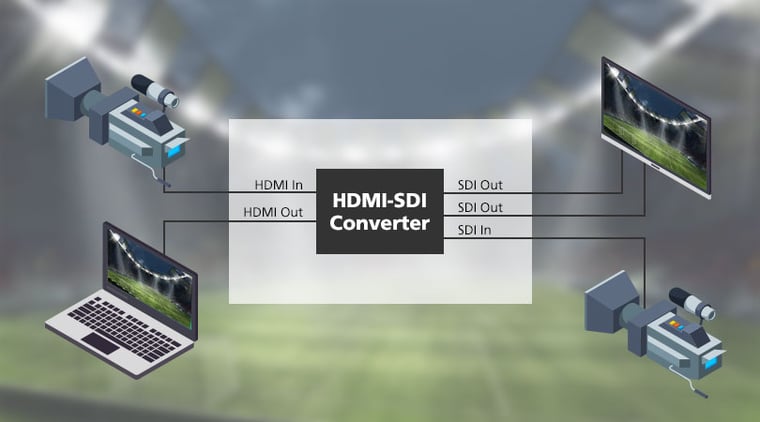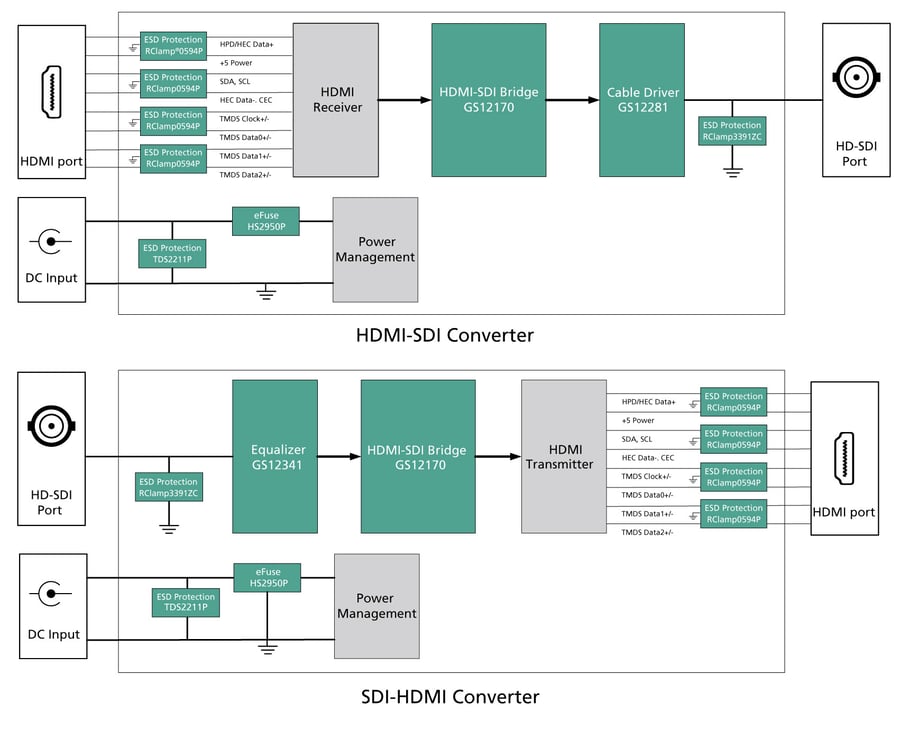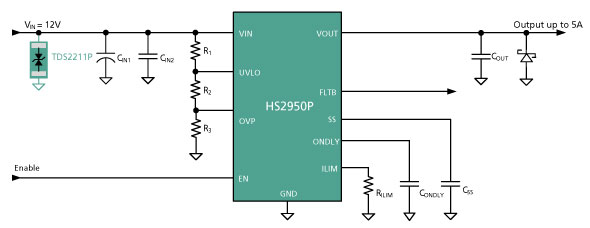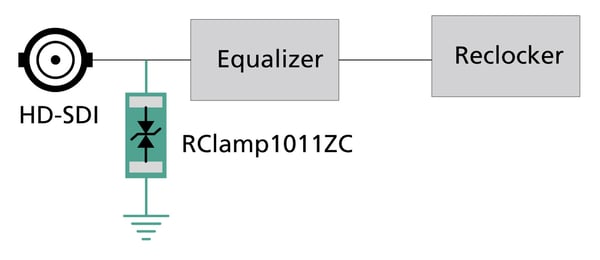Complete Protection for HDMI-SDI/SDI-HDMI Converters
Whether you are watching an action replay of a baseball game on a giant screen at a stadium, a movie on your large-screen TV or streaming a video on your laptop computer, a high-quality audiovisual (AV) experience is always expected. Ultra-High-Definition Serial Digital Interface (UHD-SDI) and High-Definition Multimedia Interface (HDMI) are two standards for digital AV transmission. UHD-SDI standardizes the transmission of uncompressed and unencrypted digital AV signals over coaxial or fiber optic cables. HDMI is a digital interface for transmitting high-definition, high-speed digital multi-track audio and uncompressed video signals from HDMI-compliant sources to AV displays. Even though they both can transport ultra-high-definition AV signals from a source to a display, HDMI is preferred to connect consumer gadgets such as computers, gaming consoles, Blu-ray/DVD players, televisions, projectors, etc. UHD-SDI is preferred for high-end applications such as professional indoor/outdoor video production and television broadcasts because it supports long-range transmission and a rugged connection with the help of a physical lock mechanism at each end of the cable. UHD-SDI coaxial cable can transfer signals up to 300 feet, whereas HDMI cables struggle with excessive signal degradation even within 50 feet. These two interfaces can be used together via an HDMI-SDI or SDI-HDMI converter. For example, as shown in figure 1, an HDMI display would be used for confidence monitoring of an SDI stream to avoid the need to use specially calibrated SDI-specific displays.

Figure 1. HDMI-SDI converter
Protection of Ports and Interfaces
An HDMI-SDI/SDI-HDMI converter box uses a DC power jack with an input voltage of 12V to power up the circuit. Abnormal power situations such as inrush current, overvoltage, short-circuit, electrical transients, and steady-state fault conditions are not uncommon in such a power line. An eFuse precisely detects those electrical surges and provides robust security to the downstream load by gracefully disconnecting it from the power source during those anomalous situations.
The other two ports besides the DC power jack of an HDMI-SDI/SDI-HDMI converter are HDMI and SDI ports. Protecting the converter's interfaces from electrostatic discharges (ESD) is imperative. We plug and unplug the ports from the converter several times, and when we touch or engage with the ports, it is possible to generate electrostatic discharge. These ESD events can be generated from a user (human body) or the stored charge on a cable. The electrostatic spike can reach up to tens of thousands of volts – easily damaging the converter's sensitive electronic circuit. Hence, ESD protection for each interface is not just important; it is essential. Semtech provides the complete protection of an HDMI-SDI/SDI-HDMI converter, as shown in the block diagram in figure 2.
 Figure 2. Protection of HDMI-SDI converter (Top) and SDI-HDMI converter (Bottom)
Figure 2. Protection of HDMI-SDI converter (Top) and SDI-HDMI converter (Bottom)
Let us look into how to shield an HDMI-SDI/SDI-HDMI converter from electrical transients, electrical overstress (EOS) and ESD events.
DC Power Line Protection
An HDMI-SDI converter box receives 12V via an adapter from a wall outlet to power up the circuit. Some modern-day converters also use a USB Type-C connector for powering the circuit. Either of these applications needs a shield against inrush current, overvoltage, under voltage, short circuit, and over-temperature faults. Semtech's HotSwitch® devices are eFuses with a low-resistance integrated MOSFET connected in series to the power rail that protects electronics systems against typical electrical transients and fault conditions. HotSwitch HS2950P is an excellent system protection solution for HDMI-SDI converters to limit currents and voltages to safe levels during fault conditions. HS2950P, shown in Figure 3, is a single-channel integrated eFuse with a wide input voltage range from 2.7V to 29V, supporting up to 5A output current and a low 25mΩ (typical) Rds(on). Bundled in a tiny 3x3mm 12-pin DFN package, HS2950P utilizes flexible and programmable protection features to handle multiple fault conditions. Programmable features include
-
Overcurrent protection
-
Precise overvoltage protection
-
Under-voltage lockout
-
A soft start to protect against inrush currents for various load requirements.
 Figure 3. Application diagram of HS2950P at 12V power line
Figure 3. Application diagram of HS2950P at 12V power line
After protecting the power line from fault conditions, we also need to consider how to protect it from ESD/EOS events. The DC power line requires an ESD protection device with more than the supply voltage, fast response time and low clamping voltage. Semtech's SurgeSwitch™ TDS2211P device is ideally suited to safeguard the DC power line of an HDMI-SDI/SDI-HDMI converter. TDS2211P, shown in Figure 3, does not use a conventional PN junction TVS diode for protection. Instead, it uses a surge-rated FET as the primary protection element, which is used as a voltage-controlled switch. Check this video to learn about the advantages of a SurgeSwitch in detail. TDS2211P has an operating voltage of 22V. It offers a minimum breakdown voltage of 25V and a peak pulse current of 40A (tp=8/20µs). TDS2211P provides transient protection as per the specification in IEC 61000-4-2 (ESD) at ±30kV (Air) and ±30kV (Contact). This part is available in a DFN package with a 1.6 x 1.6 x 0.55 mm nominal dimension.
Protection of the HDMI Port
A standard Type A HDMI connector contains 19 pins, including four high-speed transition minimized differential signal (TMDS) pairs and six non-high-speed channels (+5V power, HPD, CEC, SDA, SCL, HEC) to fulfill the digital data transition. The TMDS algorithm transmits the video and audio signals from the transmitter to the receiver using three TMDS data channels and one TMDS clock channel. In the HDMI 2.0 specification, these three channels carry differential data signals of 18Gbps, with each channel at 6Gbps. Check this video to learn more about HDMI protection.
Semtech's RClamp®0594P (Figure 4) is highly capable of protecting the high-speed differential lines and the six other non-high-speed lines of HDMI 2.0 interfaces. It protects the high-speed data lines with a typical junction capacitance of only 0.3pF. RClamp0594P has an operating voltage of 5V with a minimum breakdown voltage of 6V. It has a dynamic resistance of 0.19Ω (Typical). RClamp0594P provides transient protection as per the specification in IEC 61000-4-2 (ESD) at ±17kV (Air) and ±12kV (Contact). The flow-through package design simplifies the PCB layout and maintains the undamaged signal integrity. RClamp0594P is available in a 10-lead DFN package with a nominal dimension of 2.5 x 1.0 x 0.55 mm.
 Figure 4. ESD protection of the HDMI port
Figure 4. ESD protection of the HDMI port
Protection of the UHD-SDI Port
The 12G UHD-SDI standard transmits and receives video and embedded audio at a nominal rate of 11.88 Gbps. The standard is primarily used for 4k/UHDTV-1 (2160p) video formats. Extremely low capacitance is one of the main requirements of the needed ESD protection device for a UHD-SDI interface. The other requirement is to provide enough surge protection for the interface, as it is often used in harsh outdoor environments.
Semtech's RClamp1011ZC features superior ESD protection characteristics and is specifically designed to protect the UHD-SDI interface with BNC ports, as shown in Figure 5. It protects one bidirectional high-speed data line operating at 1.0V. It offers superb ESD protection while maintaining an exceptionally low typical line-to-line capacitance of 0.17pF, ensuring signal integrity. It also features a typical dynamic resistance of only 0.32Ω. RClamp1011ZC has a high ESD withstand voltage of ±10kV contact per IEC 61000-4-2. This device is also great for EOS protection due to its high peak pulse current capability (2.5A, tp=8/20µs). RClamp1011ZC is available in a compact 0201 DFN package (0.6x 0.3 x 0.25 mm).
 Figure 5. ESD protection of the UHD-SDI port
Figure 5. ESD protection of the UHD-SDI port
Conclusion
HDMI and UHD-SDI are two prominent AV standards. An HDMI-SDI or SDI-HDMI converter allows one to interconnect different AV equipment without any issues. The popularity of these converters is on the rise. With massive improvements in data transmission speed, video quality and resolution, the converters are more exposed to electrical transients, steady-state faults, ESD, and EOS threats. These faults can easily damage the high-end device connected to the HDMI-SDI or SDI-HDMI interface. Semtech's wide range of dependable protection products can shield any HDMI-SDI/SDI-HDMI converter from any abnormal condition. Its highly efficient HotSwitch, SurgeSwitch, and TVS diode products protect all ports and interfaces of an HDMI-SDI/SDI-HDMI converter. Consumers can experience a problem-free, fault-free connection to any HDMI-SDI/SDI-HDMI converter by shielding its ports and interfaces with Semtech protection products.
Discover product solutions on our website.
Semtech®, the Semtech logo, HotSwitch®, and RClamp® are registered trademarks or service marks, and SurgeSwitch™ is a trademark or service mark of Semtech Corporation or its affiliates. Other product or service names mentioned herein may be the trademarks of their respective owners.

